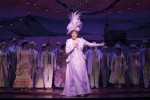“Hello, Dolly!” utilizes old tropes and stereotypes to create a musical catering to the elderly.
Running at the Hollywood Pantages Theatre until Feb. 17, the show’s central character, Dolly Gallagher Levi (Betty Buckley), opened the first act on an 1885 New York street, telling the crowd about her eclectic profession: meddling. As a professional in the field, she teaches mandolin, plays poker and arranges marriages, with the latter being the central theme of the production.
The widow creates an intricate plan to set up her “half-millionaire” love interest, Horace Vandergelder, with a woman he won’t be interested in, and convince him to marry her instead. The plot, which at one time may have seemed to showcase a vivacious and independent woman, now seems like a dated and worn-out storyline. And the almost all-white cast certainly didn’t seem to help elevate the production for a more modern audience. This classic production truly seemed to embody the time period it was created in – for better and for worse.
Overall, the humor throughout the show was aimed at an older audience, as evidenced in the first 10 minutes with a joke about varicose veins and countless quips about the woes of married life. Horace (Lewis J. Stadlen) was introduced with the number “It Takes a Woman,” which laid out his desire for a woman who could take care of him and keep his house clean. In the scene, Horace also relays his own views on how foolish it was when he was poor. The overt grumpiness and antiquated views on women intentionally made an antagonist out of Horace – unfortunate, considering that he is the love interest of our likable main character, Dolly. “Hello, Dolly!” seemed to forget that it was being shown in 2019, a time when audiences won’t soon forgive a character for spouting indiscretions about women and poor people.
The play’s visual story began next to a theatrical-looking streetcar in New York City, and the production bounced between the city and Yonkers, a city outside New York. The production’s intricate set design was evident from the beginning of the production, which continued onward with complex and beautiful scenes such as a large steam locomotive in a train station, a hay and feed store and a women’s millinery store. Much like the set design, the costumes offered an aesthetically pleasing hybrid of historical garb and vivid pastel colors. The colorful and well-crafted visual design aspect was by and large the strength of this production.
The musical went on to introduce a range of conventional characters, such as a grumpy drugstore owner, his overworked clerks, a hat shop owner and her own goofy assistant. The storyline of the play brought all of these characters together in New York City, looking for love and freedom from their old and worn-out lives.
The comic relief, Minnie Fay, played by Kristen Hahn, delivered the play’s truly hilarious moments with her awkward reactions and ill-timed outbursts. As she addressed the audience in the first act, she interacted with the crowd to hilarious effect and continued onward throughout the production to provide quirky commentary and humorous reactions in otherwise tense or beautiful situations.
Of course, newfound romance eventually comes at the show’s obligatory ending and to the satisfaction of all involved. The play conveniently pairs each of the supporting female characters with their concurrent supporting male characters, and Dolly herself falls for the wealthy man she had been pursuing for the entirety of the production.
There were no surprises here; the play was traditional and looked good, but the comedy and plotline were woefully outdated and failed to provide me with a captivating story. “Hello, Dolly!” was a predictable 2 1/2 hours in a beautiful Hollywood theater I’m sure my grandparents would fawn over.
